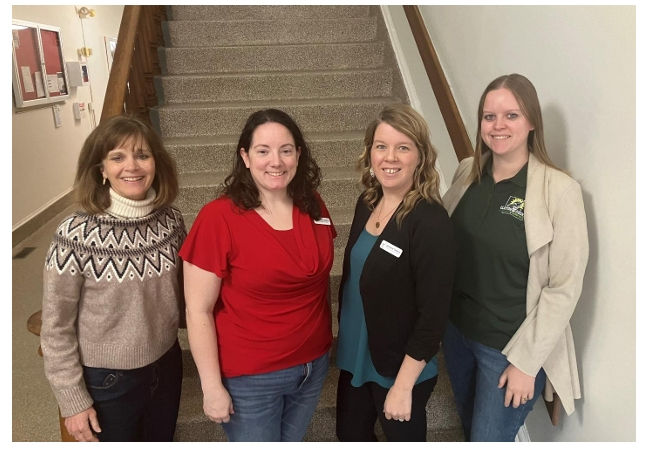News Release from the Clayton County Energy District....
Over the past several years the motivation for local governments to “go solar” has risen increasingly due to federal funding opportunities like the Inflation Reduction Act (IRA). The IRA, passed into law in 2022, reimplemented federal clean energy tax credits through 2033. Additionally, it expanded access to include non-taxable entities such as local governments, schools, hospitals, and non-profit organizations. Tax-exempt organizations can apply for a direct payment from the Investment Tax Credit for Energy Property (called Clean Electricity starting in 2025). This direct payment offers reimbursement for 30% of the cost of a renewable energy project like solar. Without incentive opportunities leading to increased returns on investment, rural governments may lose some options to expand capacity and services for their county. Solar, as one option, can provide more consistent, predictable energy bills and reduce greenhouse gas emissions.
In Clayton County, Iowa the Auditor’s Office, with resources from the Clayton County Energy District (CCED), used federal funds to offset the cost of solar which maximized their return on investment and reduced their energy footprint. Following other local successes, Clayton County Auditor Jennifer Garms proposed a solar project to County Supervisors based on the high return on investment potential and the ideal orientation of the office building located in Elkader. After Garms highlighted the benefits of the investment, the County Supervisors approved the installation of a 76-kilowatt solar system. Local contractor Wulfekuhle Electric installed the 190-panel array on the building in summer of 2023. The system is expected to produce nearly 100,000 kilowatt hours of electricity each year. During the first year this saved the county around $10,000. Accounting for continually rising energy costs over the life of the system, the average savings are estimated at over $18,000 per year.
After the system began operating in August of 2023, former CCED Program Director Joleen Jansen approached the county offering guidance to secure an Inflation Reduction Act direct payment. Jansen and fellow clean energy professionals attended webinars covering the details of the direct pay option. They shared this information with the Auditor’s office and other eligible non-taxable entities. The resources covered general requirements such as acquiring an
IRS registration number, determining an appropriate timeline for filing, proper tax forms, and other required documentation.
The Auditor’s office frequently searches for opportunities to reduce spending and make improvements without impacting tax rates or county services. In reference to the IRA direct payment Garms said, “30% is a big deal. Usually, you don’t see more than 10%”. Auditor Jennifer Garms and Deputy Auditor Amanda Sargent recognized the importance of the IRA funds and began researching the process in more detail. They initiated the first step, obtaining an IRS registration number, in January of 2024 and waited around a month for approval. The Auditor’s office spent the next few months researching how to file proper tax documentation. The 990-T form, at the time of their filing, did not have an obvious option for the IRA elective pay or for filing as a local government entity. The CCED encouraged the Auditor’s Office to employ local accounting services familiar with the 990-T submissions. They ultimately connected the County to Justin Vorwald with the Elkader Law Office. Two months after submitting their 990-T form, the county received a check for $49,199.98 in December of 2024.
When asked if they would pursue another similar project, Garms responded that the county can’t do every solar project immediately. Still, after this success they plan to expand their solar resources in the future. She also mentioned how important incentives like the IRA can be for maximizing return on investment for small local governments and ensuring projects do not negatively affect taxpayers. "Since the release of the Inflation Reduction Act in August 2022, the Clean Energy District Network has been focused on the opportunities [the IRA] presents. We recognized early on that the Direct Payment program would be a game-changer for Clayton County’s non-taxable entities, and the County stepped up as a willing pioneer. The CCED board is thrilled to see this opportunity realized and deeply grateful to the Clayton County Auditor’s staff for navigating the complexities of the process. In the end, green meets green—our community is stronger thanks to significant energy cost savings and reduced greenhouse gas emissions at the county office building." - Joleen Jansen, CCED Board Member
Without incentives the project would still provide a worthwhile investment at $164,000 with a projected 10-year payback. With the IRA direct payment providing $49,000 and American Rescue Plan Act covering another 40%, however, the upfront cost to the county dropped to under $50,000. This allowed the county to use Local Option Sales Tax dollars to cover the remaining balance without increasing tax rates or sacrificing crucial county services. At the average annual energy savings rate, this reduced the payback period to under 5 years and provides an estimated $450,000 return on investment over the life of the system!
The county has certainly recognized the benefits of renewable energy and plans to incorporate this philosophy into new county properties. Existing buildings were not planned to include solar production and consequently may not adequately meet solar requirements. The experience has shifted planning perspective to seriously consider how location, tree cover, and orientation affect solar feasibility in future county-operated buildings. An important step in planning for clean energy also includes identifying and eliminating inefficiencies. The CCED offers energy coaching and auditing services to help residents and businesses better understand their energy use and develop strategies to reduce their impact. Federal funding opportunities remain crucial for small local governments like rural Clayton County. Renewable energy incentives not only maximize opportunity for current assets but also allow local governments to plan ahead for future investments in energy savings and emission reduction.



Commentaires